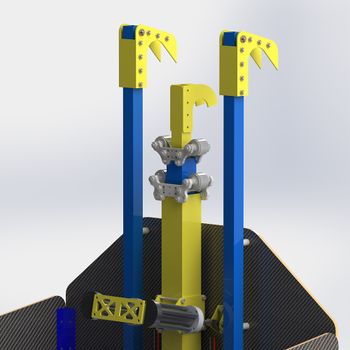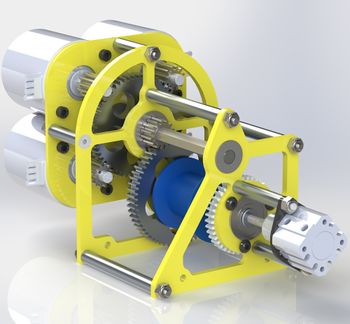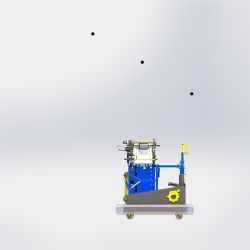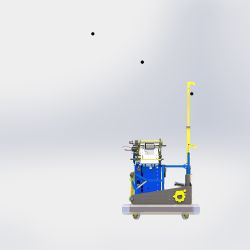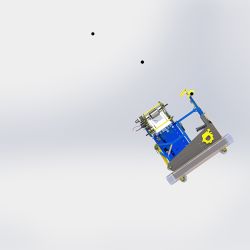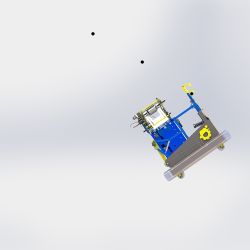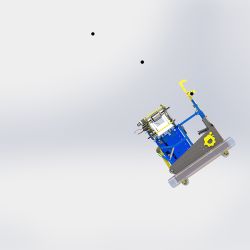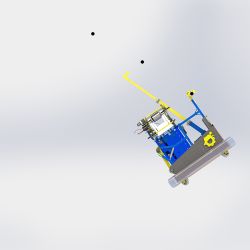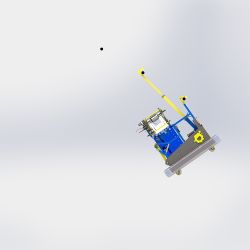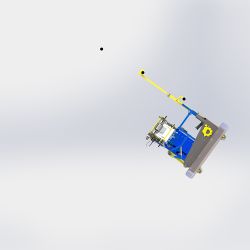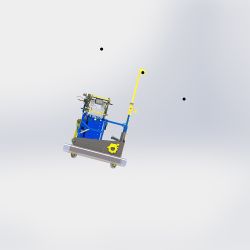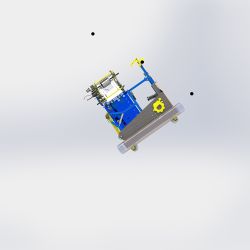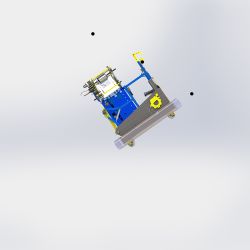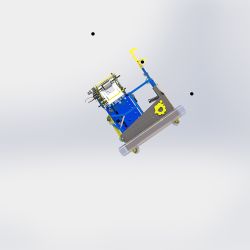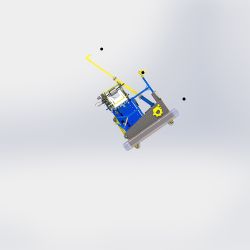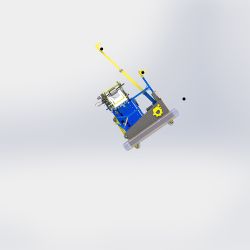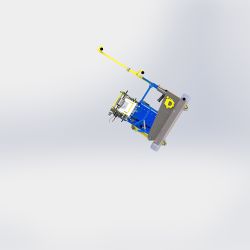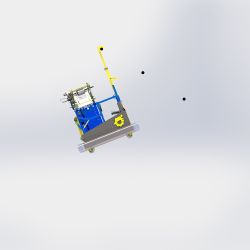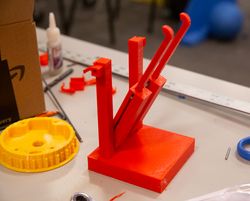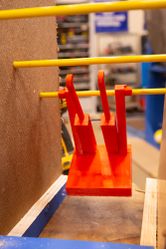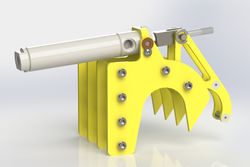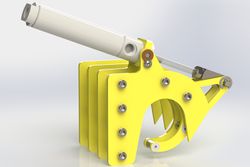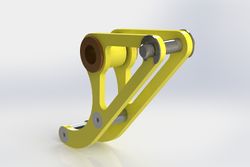Difference between revisions of "DEWBOT XVII Climber"
MaiKangWei (talk | contribs) (Created page with " ==Climbing Sequence== <gallery widths=250 heights=250 perrow=4> image:DB17_Climber-1.jpg| image:DB17_Climber-2.jpg| image:DB17_Climber-3.jpg| image:DB17_Climber-4.jpg| image...") |
MaiKangWei (talk | contribs) (→Evolution) |
||
| (29 intermediate revisions by the same user not shown) | |||
| Line 1: | Line 1: | ||
| + | [[image:DB17_20220204-1.jpg|350px|left|thumb|Climbing hooks]][[image:DB17_Climber_Gearbox_20220125.jpg|350px|right|thumb|Climber Gearbox Winch]]DEWBOT VII utilizes a 3-hook climber system allowing the robot to climb up to the TRANSVERSAL RUNG of the HANGER during end game. The Center hook arm (the Climbing Hook Arm) extends and articulates between vertical and 20° forward of vertical. The Climbing Hook Arm is modeled on a 2-stage [https://www.thethriftybot.com/bearings/Thrifty-Telescoping-Tube-Kit-p416413760 Thrifty Bot] Telescoping Tube kit. Constant force springs provide the extension force for the arm, while a Gearbox Winch controls the extension and retraction. A pair of pneumatic cylinders control the Climbing Arm angle articulation. | ||
| + | A pair of Static Hook Posts flank the Climbing Hook Arm. These Posts do not articulate, but the Static Hooks which terminate them do rotate and are spring loaded to allow the Climbing Hook to bring each RUNG to a point below the Static Hooks, then extend to transfer the RUNG from the Climbing Hook to the Static Hooks. | ||
| + | |||
| + | The Climber Gearbox employs four (4) NEO motors and 20:1 reduction designed to allow the robot to climb vertically at a speed of about 12 inches/s and deploy at about 20 inches/s. A dog-based lock allows the Gearbox to be locked into position, both to prevent inadvertent Climber Arm extension and back-driving during climbing. | ||
| + | |||
| + | I'm thinking that many robots (Including [[DEWBOT XVII]]) reaching the TRANSVERSAL RUNG will slam into the Drivers' Station window. Hard. This will certainly test the nerves of the drive team in DRIVERS STATION 1. I'm not sure whether this is a game fault or a feature. | ||
| + | <br><br><br><br><br><br><br><br><br><br><br> | ||
==Climbing Sequence== | ==Climbing Sequence== | ||
<gallery widths=250 heights=250 perrow=4> | <gallery widths=250 heights=250 perrow=4> | ||
| − | image:DB17_Climber-1.jpg| | + | image:DB17_Climber-1.jpg|Positioned ready to climb |
| − | image:DB17_Climber-2.jpg| | + | image:DB17_Climber-2.jpg|Climbing Arm extended & touching MID RUNG |
| − | image:DB17_Climber-3.jpg| | + | image:DB17_Climber-3.jpg|Climbing Arm retracted - Static Hooks compressed by MID RUNG |
| − | image:DB17_Climber-4.jpg| | + | image:DB17_Climber-4.jpg|Climbing Arm fully retracted - Static Hooks return to normal position |
| − | image:DB17_Climber-5.jpg| | + | image:DB17_Climber-5.jpg|Climbing Arm extends - MID RUNG transferred to the Static Hooks |
| − | image:DB17_Climber-6.jpg| | + | image:DB17_Climber-6.jpg|Climbing Arm rotates 20° forward and extends fully |
| − | image:DB17_Climber-7.jpg| | + | image:DB17_Climber-7.jpg|Climbing Arm rotates back to contact the HIGH RUNG |
| − | image:DB17_Climber-8.jpg| | + | image:DB17_Climber-8.jpg|Climbing Arm starts retracting - Hooks onto HIGH RUNG - Starts to pull the Static Hooks off of the MID RUNG |
| − | image:DB17_Climber-9.jpg| | + | image:DB17_Climber-9.jpg|Climbing Arm retracts further - Static Hooks pull off the MID RUNG - DEWBOT swings forward (''exciting!'') |
| − | image:DB17_Climber-10.jpg| | + | image:DB17_Climber-10.jpg|Climbing Arm continues to retract - Static Hooks compressed by HIGH RUNG |
| − | image:DB17_Climber-11.jpg| | + | image:DB17_Climber-11.jpg|Climbing Arm fully retracted - Static Hooks return to normal position |
| − | image:DB17_Climber-12.jpg| | + | image:DB17_Climber-12.jpg|Climbing Arm extends - HIGH RUNG transferred to the Static Hooks |
| − | image:DB17_Climber-13.jpg| | + | image:DB17_Climber-13.jpg|Climbing Arm rotates 20° forward and extends fully |
| − | image:DB17_Climber-14.jpg| | + | image:DB17_Climber-14.jpg|Climbing Arm rotates back to contact the TRANSVERSAL RUNG |
| − | image:DB17_Climber-15.jpg| | + | image:DB17_Climber-15.jpg|Climbing Arm starts retracting - Hooks onto TRANSVERSAL RUNG - Starts to pull the Static Hooks off of the HIGH RUNG |
| − | image:DB17_Climber-16.jpg| | + | image:DB17_Climber-16.jpg|Climbing Arm retraction pulls Static Hooks off of the HIGH RUNG - DEWBOT swings forward maybe slamming into DRIVER STATION 1 window - Climb complete |
| + | </gallery> | ||
| + | |||
| + | ==Prototyping== | ||
| + | We prototyped the climbing process with a 3-D printed robot model and cardboard & fiberglass rod HANGER. | ||
| + | <gallery widths=250 heights=250 perrow=3> | ||
| + | image:DB17_20220118-2.jpg| | ||
| + | image:DB17_20220118-3.jpg| | ||
| + | image:DB17_20220118-4.jpg| | ||
| + | </gallery> | ||
| + | |||
| + | ==Climb at Hatboro-Horsham== | ||
| + | |||
| + | {{#ev:youtube|1wEFtEV28kI|800}} | ||
| + | |||
| + | ==Evolution== | ||
| + | The pneumatic lock on the gearbox turned out to be unnecessary and the pneumatic actuator removed. | ||
| + | |||
| + | The ThriftyBot bearings were not sufficiently rugged for this application and were replaced by ? | ||
| + | |||
| + | The biggest problem we faced in early competitions was a tendency for the robot to bounce off the rung when its swing caused the bumper to hit the previous rung. Efforts to fix this problem with changes in the hook geometry were unsuccessful. Ultimately, a pneumatic latch was added to the center hook to mechanically latch this hook onto the rung. | ||
| + | <gallery widths=250 heights=250 perrow=3> | ||
| + | image:PneuLock1.JPG| | ||
| + | image:PneuLock2.JPG| | ||
| + | image:PneuLock3.JPG| | ||
</gallery> | </gallery> | ||
| + | ---- | ||
| + | [[Category:DEWBOT XVII]][[Category:Engineering]] | ||
Latest revision as of 11:26, 20 February 2023
DEWBOT VII utilizes a 3-hook climber system allowing the robot to climb up to the TRANSVERSAL RUNG of the HANGER during end game. The Center hook arm (the Climbing Hook Arm) extends and articulates between vertical and 20° forward of vertical. The Climbing Hook Arm is modeled on a 2-stage Thrifty Bot Telescoping Tube kit. Constant force springs provide the extension force for the arm, while a Gearbox Winch controls the extension and retraction. A pair of pneumatic cylinders control the Climbing Arm angle articulation.A pair of Static Hook Posts flank the Climbing Hook Arm. These Posts do not articulate, but the Static Hooks which terminate them do rotate and are spring loaded to allow the Climbing Hook to bring each RUNG to a point below the Static Hooks, then extend to transfer the RUNG from the Climbing Hook to the Static Hooks.
The Climber Gearbox employs four (4) NEO motors and 20:1 reduction designed to allow the robot to climb vertically at a speed of about 12 inches/s and deploy at about 20 inches/s. A dog-based lock allows the Gearbox to be locked into position, both to prevent inadvertent Climber Arm extension and back-driving during climbing.
I'm thinking that many robots (Including DEWBOT XVII) reaching the TRANSVERSAL RUNG will slam into the Drivers' Station window. Hard. This will certainly test the nerves of the drive team in DRIVERS STATION 1. I'm not sure whether this is a game fault or a feature.
Climbing Sequence
Prototyping
We prototyped the climbing process with a 3-D printed robot model and cardboard & fiberglass rod HANGER.
Climb at Hatboro-Horsham
Evolution
The pneumatic lock on the gearbox turned out to be unnecessary and the pneumatic actuator removed.
The ThriftyBot bearings were not sufficiently rugged for this application and were replaced by ?
The biggest problem we faced in early competitions was a tendency for the robot to bounce off the rung when its swing caused the bumper to hit the previous rung. Efforts to fix this problem with changes in the hook geometry were unsuccessful. Ultimately, a pneumatic latch was added to the center hook to mechanically latch this hook onto the rung.
